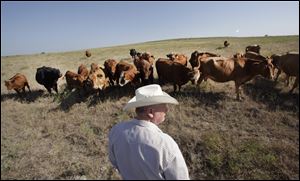
Agriculture adapts to hotter climate
Hardier breeds, crop varieties sought
8/9/2012
Cattle rancher Ron Gill examines part of his herd as he looks over his livestock's grazing pasture near Boyd, Texas. He has been cross breeding cattle with more drought-tolerant breeds that can better withstand heat and drought.
DES MOINES -- Cattle are being bred with genes from their African cousins that are accustomed to hot weather.
New corn varieties are emerging with larger roots for gathering water in a drought. Someday, the plants may even be able to "resurrect" themselves after a long dry spell, recovering quickly when rain returns.
Across American agriculture, farmers and crop scientists have concluded it's too late to fight climate change. They need to adapt to it with a new generation of hardier animals and plants specially engineered to survive, and even thrive, in intense heat, with little rain.
"The single-largest limitation for agriculture worldwide is drought," said Andrew Wood, a professor of plant physiology and molecular biology at Southern Illinois University.
On his Kansas farm, Clay Scott is testing a new kind of corn called Droughtguard as his region suffers through a second consecutive growing season with painfully scarce precipitation.
"These are products I really need," Mr. Scott said. "I couldn't be any happier that they are working on these products."
The urgency is also evident in Texas, where rainfall has been below normal since 1996. Crops and pastures were decimated in 2011 by a searing drought, and some got hit again this year. Ranchers have sold off many animals they couldn't graze or afford to feed. Cattle inventory, at 97.8 million head as of July 1, is the smallest since the U.S. Department of Agriculture began a July count in 1973.
At least one rancher is breeding cattle with genes that trace to animals from Africa and India, where their ancestors developed natural tolerance to heat and drought.
Ron Gill, a rancher who also heads the animal science department at Texas A&M University, said research has been under way for years to develop cattle that can withstand heat and grow on lower-quality forage.
Last year, he started incorporating into his herd Beefmaster cattle, a cross between Brahman cattle, which originated in India, and European breeds that include Herefords and Shorthorns. He's also experimenting with the appropriately named Hotlanders, a Texas breed developed for its heat tolerance using genetics from Senepol cows bred in the Virgin Islands.
It's no different for farmers in the nation's Corn Belt, who are confronting a drought that stretches from Ohio west to California and from Texas north to the Dakotas. Only in the 1930s and the 1950s has a drought covered more of the United States, according to the National Climatic Data Center in Asheville, N.C.
Nearly half of the nation's corn crop is in poor or very poor condition, as well as a third of soybeans.
The damage would be much worse without the crop science advancements of the last 40 years, said Mr. Wood, the Southern Illinois professor.